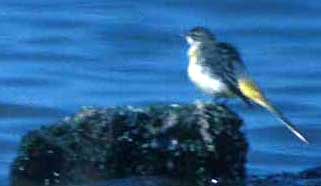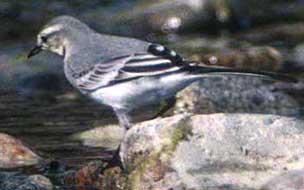MONTEREY WAGTAILS
by Don Roberson
Monterey County birders are fortunate to have recorded four species
of wagtails: Yellow Wagtail Motacilla flava, Gray Wagtail M.
cinerea, Black-backed Wagtail M. lugens, and White Wagtail
M.
alba; it is presumed on geographic grounds that any White Wagtail
in
western North America is of the race M. a. ocularis which
breeds
in northeast Asia (sometimes called the "Swinhoe's White Wagtail"). Two
individual wagtails in the White/Black-backed group in Monterey County
have stirred significant interest and debate. I have separate pages
full
of photos and commentary on these:
As it happens, both wagtails were found by observers who were unsure
which
species they were seeing. I was telephoned on both birds and asked to
help
try to identify them in the field. During these efforts I also tried to
obtain photos. I believe both birds were White Wagtails of the race ocularis
but the California Bird Records Committee (CBRC) does not agree at this
point. Recent information, however, may change this status. I consider
them White Wagtails in the listing below. One of the White Wagtails and
the only Black-backed Wagtail frequented sites on the Pajaro River
which
divides Monterey County ("MTY) from Santa Cruz County ("SCZ") to the
north.
Santa Cruz County also has an early September record of Yellow Wagtail.
The identification of wagtails in this group is notorious difficult,
probably because they are so closely related. They were split as
separate
species by the AOU (1983) "because they are sympatric with limited
hybridization
in Kamchatka and southern Ussuriland (Kistchinshi & Lobkov 1979)"
[quote
from AOU 1998]. Both species have been recorded several times in
California.
There are three primary sources of identification information to which
I have referred over the past decade: Morlan (1981), BMRC (1983), and
Sibley
& Howell (1998). However, a new book by Per Alström and
Krister
Mild on wagtails and pipits is currently (Nov 2001) in press heading
for
publication in fall 2002.
Recent biochemical evidence suggests that "Yellow Wagtail" may
actually
be a composite of three separate species (Voelker 2002); if so, the MTY
record is presumably from the NE Asian population on geographic grounds
[in 2004 the AOU adopted this split; see below]. Likewise, White and
Black-backed
Wagtails are from NE Asia, although it is possible that they should not
be considered separate species, even though it is also possible that
"White
Wagtail" is an amalgam of several species (Voelker 2002). Research
continues
on these interesting questions.
Monterey County records of wagtails to date are:
EASTERN YELLOW WAGTAIL Motacilla tschutschensis
An immature seen at Pt. Pinos on the beach opposite
from Crespi Pond on 19 Sep 1982 by Jon L. Dunn and his tour group and
by
Ronald L. Branson. This bird was not photographed but details were
accepted
by the CBRC. The early September occurrence is consistent with the
dates
of other vagrant Yellow Wagtails in California. This was the fourth
state
record at the time.
In July 2004, the AOU split the Yellow Wagtails
M. flava of Eurasia, although they did not delineate just how
they
would do this. Rather, for purposes of North America, they considered
those
that have occurred to be Eastern Yellow Wagtail M. tschutschensis
GRAY WAGTAIL Motacilla cinerea
 An immature was discovered at the Salinas River mouth 9-10 Oct 1988 by
David A. Sibley. During its two-day stay it was viewed by many
interested
observers and various photos were taken (photo right ©
2001
Don
Roberson). This was the first state record of Gray Wagtail and
remains
the only California record to date (Feb 2001), and one of very few for
North America. Besides the plumage pattern, note also the slim shape
and
very long tail.
An immature was discovered at the Salinas River mouth 9-10 Oct 1988 by
David A. Sibley. During its two-day stay it was viewed by many
interested
observers and various photos were taken (photo right ©
2001
Don
Roberson). This was the first state record of Gray Wagtail and
remains
the only California record to date (Feb 2001), and one of very few for
North America. Besides the plumage pattern, note also the slim shape
and
very long tail.
WHITE WAGTAIL Motacilla alba
Two records: a first-year bird was at Moonglow
Dairy, Moss Landing 23 Dec 1988-21 Jan 1989, returned to the Pajaro R.
mouth on both sides of the MTY/SCZ line 4-11 Dec 1989, and returning a
third winter at Pajaro R. mouth 7 Nov-1 Dec 1990 and moving back to
Moonglow
Dairy 21 Dec 1990-21 Jan 1991. Many photos and commentary on this
saga are linked by clicking HERE
or on the left-hand photo below.
Another first-year bird was along the Big Sur River
near the river mouth 28 Sep 1998. Many photos and commentary on that
bird
are linked by clicking HERE
or on the right-hand photo below. [Both photos below
©
D.
Roberson]
BLACK-BACKED WAGTAIL Motacilla lugens
 An adult returned to the Watsonville sewage ponds, SCZ, 7 Aug-22 Sep
1979
and on 20 Jul-21 Sep 1980. Initially found by Carolyn Fredricksen and
Steve
Allison, it was a first California record and viewed by many observers.
It also spent time in the Pajaro River bed and on at least 17 Aug 1979
was seen foraging and flying on the MTY side of this border stream. The
photograph (right © Al Ghiorso) was submitted to
the
CBRC and accepted. The huge white wingpatch comprising all the
upperwing
coverts is visible in this shot and forms a large white area on the
wing
in flight.
An adult returned to the Watsonville sewage ponds, SCZ, 7 Aug-22 Sep
1979
and on 20 Jul-21 Sep 1980. Initially found by Carolyn Fredricksen and
Steve
Allison, it was a first California record and viewed by many observers.
It also spent time in the Pajaro River bed and on at least 17 Aug 1979
was seen foraging and flying on the MTY side of this border stream. The
photograph (right © Al Ghiorso) was submitted to
the
CBRC and accepted. The huge white wingpatch comprising all the
upperwing
coverts is visible in this shot and forms a large white area on the
wing
in flight.
LITERATURE CITED
American Ornithologists' Union. 1983. Check-list of North
American
Birds. 6th ed. A.O.U., Washington, D.C.
American Ornithologists' Union. 1998. Check-list of North American
Birds.
7th ed. A.O.U., Washington, D.C.
Bird Migration Research Center (BMRC). 1983. Bird-banding Manual,
Identification
Guide to Japanese Birds 2:7-11. Yamashima Inst. Ornithol., Shibuya,
Tokyo
(text in Japanese; scientific names in Latin)
Howell, S.N.G. 1989. Identification of White and Black-backed
wagtails
in alternate plumage. West. Birds 21: 41-49.
Kistchinski, A.A. and E.G. Lobkov. 1979. [Spatial relationships
between
some bird subspecies in the Beringian forest-tundra.] Moskov. Obs. 1
Spyt.
Prirody, Otd. Biol. Bull. (n.s.) 5:11-23 (in Russian)
Morlan, J. 1981. Status and identification of forms of White
Wagtail
in western North America. Continental Birdlife 2:37-50.
Sibley, D.A., and S.N.G. Howell. 1998. Identification of White and
Black-backed
wagtails in basic plumage. West. Birds 29:180-198.
Voelker, G. 2002. Systematics and historical biogeography of
wagtails:
dispersal versus vicariance revisited. Condor 104:725-739.
TOP
BACK TO
MONTEREY
COUNTY PAGE
GO TO HOME PAGE
GO TO BIRDING
THE
WORLD PAGE
GO TO BIRD
FAMILIES
OF THE WORLD
Page created 26 May 2000 & 7 Feb 2001 & 14 Nov
2002
 An immature was discovered at the Salinas River mouth 9-10 Oct 1988 by
David A. Sibley. During its two-day stay it was viewed by many
interested
observers and various photos were taken (photo right ©
2001
Don
Roberson). This was the first state record of Gray Wagtail and
remains
the only California record to date (Feb 2001), and one of very few for
North America. Besides the plumage pattern, note also the slim shape
and
very long tail.
An immature was discovered at the Salinas River mouth 9-10 Oct 1988 by
David A. Sibley. During its two-day stay it was viewed by many
interested
observers and various photos were taken (photo right ©
2001
Don
Roberson). This was the first state record of Gray Wagtail and
remains
the only California record to date (Feb 2001), and one of very few for
North America. Besides the plumage pattern, note also the slim shape
and
very long tail.


 An adult returned to the Watsonville sewage ponds, SCZ, 7 Aug-22 Sep
1979
and on 20 Jul-21 Sep 1980. Initially found by Carolyn Fredricksen and
Steve
Allison, it was a first California record and viewed by many observers.
It also spent time in the Pajaro River bed and on at least 17 Aug 1979
was seen foraging and flying on the MTY side of this border stream. The
photograph (right © Al Ghiorso) was submitted to
the
CBRC and accepted. The huge white wingpatch comprising all the
upperwing
coverts is visible in this shot and forms a large white area on the
wing
in flight.
An adult returned to the Watsonville sewage ponds, SCZ, 7 Aug-22 Sep
1979
and on 20 Jul-21 Sep 1980. Initially found by Carolyn Fredricksen and
Steve
Allison, it was a first California record and viewed by many observers.
It also spent time in the Pajaro River bed and on at least 17 Aug 1979
was seen foraging and flying on the MTY side of this border stream. The
photograph (right © Al Ghiorso) was submitted to
the
CBRC and accepted. The huge white wingpatch comprising all the
upperwing
coverts is visible in this shot and forms a large white area on the
wing
in flight.